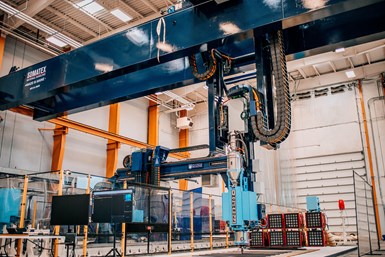UMaine’s FoF 1.0 Large-Scale 3D Printer Shatters Former Guinness World Record for Additive Manufacturing
The large-scale thermoplastic polymer printer offers new opportunities for eco-friendly and cost-effective manufacturing for numerous industries, including national security, affordable housing, bridge construction, ocean and wind energy technologies, and maritime vessel fabrication.
Surpassing its own 2019 Guinness World Record for the largest polymer 3D printer, the University of Maine has unveiled the Factory of the Future 1.0 (FoF 1.0), a next-generation printer which is four times larger than its predecessor.
The FoF 1.0 was unveiled at the university’s Advanced Structures and Composites Center (ASCC) to an audience that included representatives from the U.S. Department of Defense, U.S. Department of Energy, the Maine State Housing Authority, industry partners and other stakeholders that plan to utilize this technology.
The thermoplastic polymer printer is designed to print objects as large as 96 ft. long × 32 ft. wide × 18 ft. high, and can print up to 500 lbs/hr. The company says the printer offers new opportunities for eco-friendly and cost-effective additive manufacturing (AM) for numerous industries, including national security, affordable housing, bridge construction, ocean and wind energy technologies, and maritime vessel fabrication.
The design and fabrication of this printer and hybrid AM system was made possible with support from the Office of the Secretary of Defense through the U.S. Army Corps of Engineers.
FoF 1.0 isn’t merely a large-scale printer, it can also switch between various processes such as large-scale AM, subtractive manufacturing, continuous tape layup and robotic arm operations. It is said that access to it and MasterPrint, the ASCC’s first world record-breaking 3D printer, can streamline manufacturing innovation research at the center. The two large printers can collaborate by sharing the same end effectors or by working on the same part.
“UMaine and the Advanced Structures and Composites Center possess the innovation, capacity and workforce to support the future needs of the Department of Defense in advanced manufacturing,” says Sen. Susan Collins. “This is a great day for our university, our state and our nation. I congratulate President Joan Ferrini-Mundy and Dr. Habib Dagher on another important milestone and look forward to witnessing this center’s continued innovation that is invaluable to our national security.”
Since fiscal year 2022, Collins, vice chair of the Senate Appropriations Committee and Subcommittee on Defense, has secured more than $93 million in support of this initiative and other defense projects at the ASCC.
“FoF 1.0 opens up new research frontiers to integrate these collaborative robotics operations at a very large scale with new sensors, high-performance computing and artificial intelligence to create born-certified systems that meet high quality standards,” says Habib Dagher, ASCC executive director. “We are grateful for Senator Collins’ support, for support from Maine’s congressional delegation and for collaborations with the Department of Defense, Department of Energy, Oak Ridge National Labs, Maine Housing and our industry partners here in Maine and beyond.”
The one-of-a-kind printer will advance various initiatives, including the development of biobased feedstocks from wood residuals abundant in Maine. This technology will advance commercialization efforts such as BioHome3D and the creation of sustainable, affordable housing, while also propelling crucial technological advancements for national security, particularly in lightweight rapidly deployable structures and vessel technologies.
“The Department of Defense has been advancing composites and manufacturing technologies with the University of Maine ASCC for nearly two decades. The latest innovations in manufacturing, composite technologies and materials coming from our universities have and will continue to be instrumental to the security and economic vitality of the U.S. and its allies and partners worldwide,” says Heidi Shyu, undersecretary of defense for research and engineering (OUSD (R&E)) and chief technology officer for the Department of Defense.
“I want to congratulate the University of Maine on achieving yet another major research and development milestone and thank our state, federal, industry and philanthropic partners for their steadfast support that makes this progress for Maine possible,” says Dannel Malloy, University of Maine system chancellor. “With this massive new 3D printer and the soon-to-be-built Green Engineering and Materials Factory of the Future, Maine’s R1 university will further its global leadership in advanced manufacturing and materials science, ensure our flagship is a destination for education and research at the intersection of engineering and computing, and accelerate solutions that strengthen the state's economy and communities.”
The university says that this new capability reinforces UMaine's Carnegie R1 research designation and also reaffirms its standing as leaders in composite materials research and advanced manufacturing. “With the participation of different departments, faculty, students and university partners, today stands as a testament to UMaine's commitment to collaborative excellence. It not only empowers us to nurture the leaders of tomorrow, but also ignites growth and prosperity within Maine's local industries and across the national stage,” said Joan Ferrini-Mundy, UMaine president.
The FoF 1.0 unveiling comes ahead of this summer's planned groundbreaking of a new 47,000-square-foot research laboratory called the Green Engineering and Materials (GEM) Factory of the Future. Scheduled for an August groundbreaking, the facility is positioned to enhance manufacturing innovation across multiple sectors. Its primary aim is to facilitate and scale up more sustainable manufacturing practices by introducing next-generation solutions and biomaterials, addressing challenges such as a diminishing workforce and strained supply chains with local solutions.
“Maine needs an estimated 80,000 additional homes by 2030, many specifically for households with incomes at or below the area median income. This new technology allows UMaine-ASCC to scale-up its research and production of its innovative biobased 3D printed home technology,” says Mark Wiesendanger, MaineHousing’s development director. “This effort creates another means of producing quality affordable housing, while further driving costs down, and using abundant wood residuals from Maine’s sawmills. We look forward to continuing our collaboration with Dr. Dagher, the staff and students at UMaine/ASCC in demonstrating how 3D printed homes and other next-generation housing technologies will quickly and efficiently contribute to enhancing Maine’s housing stock.”
The research facility will not only scale up advanced manufacturing processes but also explore innovative materials systems by prioritizing recycled and biobased materials. Maine, the most forested state in the U.S., annually produces more than one million tons of wood residuals in its sawmills, which can be used as feedstock for 3D printing. In addition, UMaine, with the GEM initiative, has prioritized manufacturing workforce development by offering experiential learning and entrepreneurial training programs aimed at nurturing the next generation of leaders.
In tandem with research and development, the GEM Factory of the Future aligns with the formation of the Maine College of Engineering and Computing (MCEC), a statewide initiative funded by the Harold Alfond Foundation as part of UMS TRANSFORMS that prioritizes developing a workforce prepared for the increasingly interconnected and digital global economy.
“The Maine College of Engineering and Computing is proud to be a strong partner in developing the Factory of the Future 1.0,” says Giovanna Guidoboni, inaugural dean of MCEC. “This partnership brings together engineering and material technologies together with advanced computing, creating unprecedented hands-on learning experiences in advanced manufacturing for our students and providing venues to develop new classes, electronic credentials and new majors.”
Related Content
Sidus Space Successfully Launches LizzieSat Hybrid 3D-Printed Satellite
The hybrid 3D-printed satellite was manufactured using Markforged 3D printers for parts that would be incredibly lightweight, durable and custom to the structure to ensure the satellite remains intact during launch and works properly for its full life span in space.
Read MoreVideo: For 3D Printed Aircraft Structure, Machining Aids Fatigue Strength
Machining is a valuable complement to directed energy deposition, says Big Metal Additive. Topology-optimized aircraft parts illustrate the improvement in part performance from machining as the part is being built.
Read MoreJuggerBot 3D Awarded $4 Million by Air Force to Develop Large Format Hybrid Additive System
The project focuses on advancing the ability to print a thermoset composite material that can transform the way an aircraft structure is designed, fabricated and sustained for limited-life aircraft.
Read MoreMachine Tool Drawbar Made With Additive Manufacturing Saves DMG MORI 90% Lead Time and 67% CO2 Emission
A new production process for the multimetal drawbar replaces an outsourced plating step with directed energy deposition, performing this DED along with roughing, finishing and grinding on a single machine.
Read MoreRead Next
Profilometry-Based Indentation Plastometry (PIP) as an Alternative to Standard Tensile Testing
UK-based Plastometrex offers a benchtop testing device utilizing PIP to quickly and easily analyze the yield strength, tensile strength and uniform elongation of samples and even printed parts. The solution is particularly useful for additive manufacturing.
Read More3D Printed Polymer EOAT Increases Safety of Cobots
Contract manufacturer Anubis 3D applies polymer 3D printing processes to manufacture cobot tooling that is lightweight, smooth and safer for human interaction.
Read MoreCrushable Lattices: The Lightweight Structures That Will Protect an Interplanetary Payload
NASA uses laser powder bed fusion plus chemical etching to create the lattice forms engineered to keep Mars rocks safe during a crash landing on Earth.
Read More





















